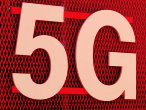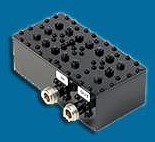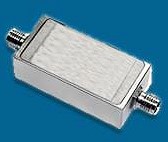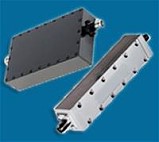|

Sam Benzacar, of RF and microwave filter company
Anatech Electronics,
has penned this piece entitled, "5G Fact and Fiction" as part of his January newsletter.
Sam keeps abreast of all the latest news in the wireless world, which is not unexpected
given his company's long-time involvement in helping others make their products
play well together in an increasingly crowded electromagnetic spectrum - both licensed
and unlicensed. The term "5G" is still a relatively fuzzy entity whose definition
is still being constructed by the telecom industry's engineers, marketeers, and
the news media. Also included are a few other topics including Google's high power
automotive radar, 5G at this year's CES show, Ford's cellular vehicle-to-everything
(C-V2X) scheme, and the Bluetooth SIG push for IoT.
A Word from Sam Benzacar
 5G Fact
and Fiction
By Sam Benzacar
With the enormous amount of hype surrounding 5G, one fact cannot be disputed:
marketing works. The claims may be dubious, like AT&T's placing a "5G E" icon
on the of some smartphone displays for its "5G Evolution" product that isn't 5G,
"real" 5G coming to smartphones early this year, and an assortment of other claims
in the last few years. But the marketing has worked, and if you don't believe me,
look at the chart below, which represent the results of my basic Google search for
various topics.
The search delivered 570 million results for 5G, higher than those for some entire
countries, and "only" 227 million fewer than for 4G that has been around for years
and was promoted for years before that. And 5G isn't even here yet. So yes, marketing
works and for 5G its results are truly stupendous, and now that 5G is actually very
close to fruition, it's making an already complex topic even more confusing.
 So where are we, really, with 5G? We're
edging our way into it in stages, first of which arrived as fixed wireless access
(FWA) when Verizon rolled out its 5G Home offering in Sacramento and three other
cities in October, making it the first actual 5G deployment. It's essentially a
limited version of its Fios fiber-to-the-home offering delivered wirelessly at 28
GHz – except faster. Downstream speeds are guaranteed to be at least 300 Mb/s and
up to 1 Gb/s in the best conditions, and the company says it will double them in
6 months. So where are we, really, with 5G? We're
edging our way into it in stages, first of which arrived as fixed wireless access
(FWA) when Verizon rolled out its 5G Home offering in Sacramento and three other
cities in October, making it the first actual 5G deployment. It's essentially a
limited version of its Fios fiber-to-the-home offering delivered wirelessly at 28
GHz – except faster. Downstream speeds are guaranteed to be at least 300 Mb/s and
up to 1 Gb/s in the best conditions, and the company says it will double them in
6 months.
So far, AT&T is on the fence concerning its own FWA deployment instead focusing
on what its 5G Evolution strategy, which is what the rest of the industry calls
LTE-Advanced. 5G Evolution is really LTE with 4×4 MIMO, three-way carrier aggregation,
256 QAM, and the used of LTE Licensed Assisted Access (LAA) frequencies at 5 GHz.
Speeds "can" be high, up to 400 Mb/s downstream, which is impressive. However, it
requires a new smartphone, of which there is currently one: the Motorola Z3 and
its required (and bulky) "Moto Mod" attachment and 5G power pack.
 In AT&T's case, their marketing has backfired,
making it a target for Verizon and T-Mobile, which are having a field day refuting
5G Evolution. To be fair, AT&T released a statement last April "Setting the
Record Straight on 5G Evolution", noting that it is "evolving" to 5G rather than
providing it now. Will customers get that message? Probably not. In AT&T's case, their marketing has backfired,
making it a target for Verizon and T-Mobile, which are having a field day refuting
5G Evolution. To be fair, AT&T released a statement last April "Setting the
Record Straight on 5G Evolution", noting that it is "evolving" to 5G rather than
providing it now. Will customers get that message? Probably not.
As for 5G smartphones, it's likely that the first devices that could reasonably
be called 5G-capable will be available later this year with big announcements at
CES this month and at Mobile World Congress next month. All will be Android phones
as Apple always until the technology is fully cooked before offering it, so don't
expect a 5G iPhone until 2020.
 Higher-Power Google Radar Gets FCC OK Higher-Power Google Radar Gets FCC OK
The FCC has approved Google's request to increase the output power of its Project
Soli high-resolution millimeter-wave radar that designed to capture motion in 3D
to enable touchless control of device functions. It could benefit users with mobility,
speech and tactile impairments, and potentially have other uses as well. Researchers
at the University of St. Andrews in Scotland have demonstrated its ability to count
sheets of paper, playing cards, poker chips, and recognizing the orientation of
Lego blocks stacked on top of the sensor.
 5G Phones Emerge
at CES 5G Phones Emerge
at CES
Sprint says a 5G smartphone from Samsung will be available this summer that supports
some of its spectrum including 2.5 GHz, 1.9 GHz, and 800 MHz, and Verizon is taking
advantage of the "bolt-on" function capabilities of Lenovo's Motorola Moto 3 to
allow it to be 5G enabled with availability in the first half of the year. Samsung
also showed another 5G-capable phone that will initially be exclusive to Verizon.
Other manufacturers are likely to join this small group in the coming months.
 Ford Reaffirms Plans for C-V2X Ford Reaffirms Plans for C-V2X
Ford has announced its commitment to deploy cellular vehicle-to-everything (C-V2X)
technology in all new Ford U.S. vehicles in 2022 and will enable conventional cellular
connectivity by the end of this year. C-V2X is an LTE variant that will presumably
replace the DSRC approach long expected to become the standard for vehicle connectivity
but has effectively been superseded by cellular technology. C-V2X allows direct
communication between connected devices without the need for an intermediary trip
to a base station, which simplifies the connection path and reduces latency.
 Bluetooth SIG Pushing Hard for IoT Bluetooth SIG Pushing Hard for IoT
Bluetooth Special Interest Group (SIG) is working hard to make Bluetooth mesh
the key protocol for the smart home, after becoming the last short-range standard
to include mesh capability. The SIG has created a new Smart Home Subgroup to speed
up adoption of Bluetooth mesh networking with new mesh specifications for "smart"
homes. The models define device behavior such as how a Bluetooth mesh switch will
control a light.
Anatech Electronics Introduces a New Line of Suspended Stripline and
Waveguide Type RF Filters
Check out Our Filter Products



Cavity Band Pass Filters
LC Band Pass Filters Cavity Bandstop/Notch Filter
About Anatech Electronics
Anatech Electronics, Inc. (AEI) specializes in the design and manufacture of
standard and custom RF and microwave filters and other passive components and subsystems
employed in commercial, industrial, and aerospace and applications. Products are
available from an operating frequency range of 10 kHz to 30 GHz and include cavity,
ceramic, crystal, LC, and surface acoustic wave (SAW), as well as power combiners/dividers,
duplexers and diplexers, directional couplers, terminations, attenuators, circulators,
EMI filters, and lightning arrestors. The company's custom products and capabilities
are available at www.anatechelectronics.com.
Contact:
Anatech Electronics, Inc. 70 Outwater Lane Garfield, NJ 07026 (973)
772-4242
sales@anatechelectronics.com
Posted January 22, 2019
|































 In AT&T's case, their marketing has backfired,
making it a target for Verizon and T-Mobile, which are having a field day refuting
5G Evolution. To be fair, AT&T released a statement last April "Setting the
Record Straight on 5G Evolution", noting that it is "evolving" to 5G rather than
providing it now. Will customers get that message? Probably not.
In AT&T's case, their marketing has backfired,
making it a target for Verizon and T-Mobile, which are having a field day refuting
5G Evolution. To be fair, AT&T released a statement last April "Setting the
Record Straight on 5G Evolution", noting that it is "evolving" to 5G rather than
providing it now. Will customers get that message? Probably not. Higher-Power Google Radar Gets FCC OK
Higher-Power Google Radar Gets FCC OK
 5G Phones Emerge
at CES
5G Phones Emerge
at CES  Ford Reaffirms Plans for C-V2X
Ford Reaffirms Plans for C-V2X  Bluetooth SIG Pushing Hard for IoT
Bluetooth SIG Pushing Hard for IoT




